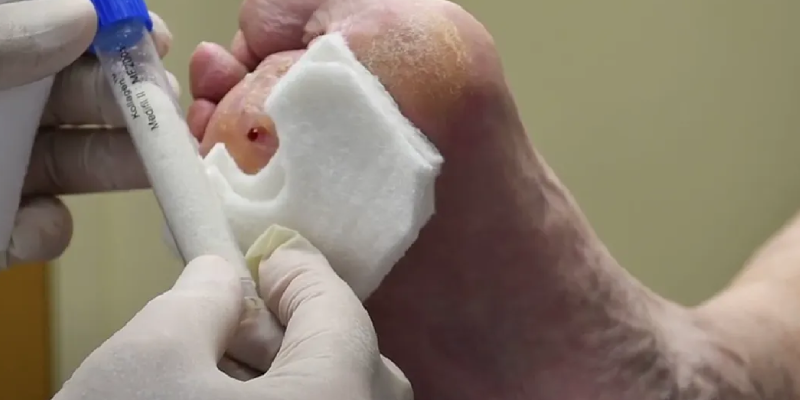
Diabetic Wound & Dressing
Diabetic wound care and dressing are critical components of diabetes management, as individuals with diabetes are more prone to developing slow-healing wounds, particularly in the feet and lower limbs. High blood sugar levels can damage blood vessels and nerves, leading to poor circulation and reduced sensation. This makes patients vulnerable to injuries, infections, and non-healing ulcers that can worsen without timely medical attention. Proper wound care not only promotes healing but also prevents severe complications such as infections, gangrene, or even the need for amputation.
Causes and Risk Factors
Diabetic wounds develop due to a combination of factors associated with diabetes. These include poor circulation, neuropathy, and weakened immune function. Common causes and risk factors are:
– Peripheral neuropathy leading to reduced sensation in feet and legs
– Poor blood circulation due to damaged blood vessels
– Uncontrolled blood sugar levels slowing down healing
– Repeated trauma or unnoticed injuries to feet and toes
– Obesity and sedentary lifestyle
– Wearing ill-fitting footwear
– History of diabetic foot ulcers or infections
Symptoms That May Require Dressing and Treatment
Patients with diabetes should monitor their skin regularly for early signs of wounds or ulcers. Medical attention and wound dressing may be required if the following symptoms appear:
– Non-healing cuts, blisters, or ulcers, especially on the feet
– Persistent redness, swelling, or warmth around the wound
– Pus discharge or foul odor indicating infection
– Thickened skin, corns, or calluses turning into open sores
– Pain, numbness, or tingling in the affected area
– Darkening of skin around the wound, suggesting poor blood supply
Diagnosis
Diagnosis begins with a thorough medical history and physical examination of the wound. The doctor may assess blood sugar levels, circulation, and nerve function. Additional diagnostic steps may include:
– Wound swab or culture to identify infection-causing bacteria
– Blood tests to check glucose control and immune function
– Doppler ultrasound or ankle-brachial index to assess blood flow
– X-rays or MRI in cases of deep or chronic wounds to rule out bone infection (osteomyelitis)
Types of Wound Care and Dressing Methods
Diabetic wound management involves specialized dressings and treatments designed to promote faster healing and prevent infection. Common techniques include:
– Basic Wound Dressing: Regular cleaning with saline and sterile dressing to keep the wound protected and moist.
– Advanced Dressings: Hydrocolloid, foam, or alginate dressings that maintain moisture balance and encourage tissue repair.
– Negative Pressure Wound Therapy (NPWT): Use of vacuum-assisted closure to remove fluids, reduce swelling, and enhance blood flow.
– Debridement: Removal of dead or infected tissue to promote healthy tissue growth.
– Infection Control: Application of topical or systemic antibiotics when bacterial infection is detected.
– Skin Substitutes & Growth Factors: Bioengineered skin or growth factor therapy to stimulate healing in stubborn wounds.
– Offloading: Use of special footwear, casts, or orthotic devices to reduce pressure on diabetic foot ulcers.
Prevention and Self-Care
Preventing diabetic wounds is as important as treating them. People with diabetes should follow proper foot care and wound prevention practices:
– Keep blood sugar levels under control
– Inspect feet daily for cuts, blisters, or color changes
– Wash and moisturize feet regularly to avoid dryness and cracking
– Wear well-fitted, protective footwear
– Avoid walking barefoot to reduce injury risk
– Quit smoking to improve blood circulation
– Visit a doctor regularly for foot check-ups
Conclusion
Diabetic wound and dressing care play a vital role in preventing severe complications in people with diabetes. Early detection, proper wound management, and strict blood sugar control can significantly reduce the risk of chronic ulcers and amputations. With the right medical attention, advanced wound care techniques, and lifestyle modifications, diabetic patients can lead a healthier, complication-free life.

